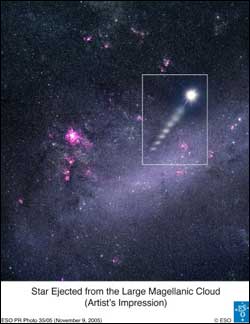Star on the Run

Star Ejected from the Large Magellanic Cloud (Artist’s Impression)
Speeding Star Observed with VLT Hints at Massive Black Hole
Using ESO’s Very Large Telescope, astronomers [1] have recorded a massive star moving at more than 2.6 million kilometres per hour. Stars are not born with such large velocities. Its position in the sky leads to the suggestion that the star was kicked out from the Large Magellanic Cloud, providing indirect evidence for a massive black hole in the Milky Way’s closest neighbour. These results will soon be published in the Astrophysical Journal Letters [2].
“At such a speed, the star would go around the Earth in less than a minute!”, says Uli Heber, one of the scientists at the Dr. Remeis-Sternwarte (University of Erlangen-Nürnberg, Germany) and the Centre for Astrophysics Research (University of Hertfordshire, UK) who conducted the study.
The hot massive star, (named HE 0437-5439), was discovered in the framework of the Hamburg/ESO sky survey far out in the halo of the Milky Way, towards the Doradus Constellation (“the Swordfish”).
“This is a rather unusual place for such a star: massive stars are ordinarily found in the disc of the Milky Way”, explains Ralf Napiwotzki, another member of the team. “Our data obtained with the UVES instrument on the Very Large Telescope, at Paranal (Chile), confirm the star to be rather young and to have a chemical composition similar to our Sun.”
The data also revealed the high speed of the star, solving the riddle of its present location: the star did not form in the Milky Way halo, but happens to be there while on its interstellar – or intergalactic – travel.
“But when we calculated how long it would take for the star to travel from the centre of our Galaxy to its present location, we found this to be more than three times its age”, says Heber. “Either the star is older than it appears or it was born and accelerated elsewhere”, he adds.
As a matter of fact, HE0457-5439 lies closer to one of the Milky Way satellite galaxies, the Large Magellanic Cloud, located 160,000 light-years away from us. The astronomers find it likely for the star to have reached its present position had it been ejected from the centre of the LMC. This could imply the existence of a massive black hole inside the LMC, in order to have imparted the speeding star the necessary kick.
Another explanation would require the star to be the result of the merging of two stars. In this case, the star could be older that presently thought, giving it time to have travelled all the way from the Milky Way Centre. This scenario, however, requires quite some fine-tuning. The astronomers are now planning new observations to confirm one of the two scenarios.
The full text of this ESO Press release 27/05 and the associated artist’s impression is available at http://www.eso.org/outreach/press-rel/pr-2005/pr-27-05.html
Notes
[1] The astronomers are Heinz Edelmann (Dr. Remeis-Sternwarte of the University of Erlangen-Nürnberg, Germany, now at University of Texas, Austin, USA), Ralf Napiwotzki (Centre for Astrophysics Research, University of Hertfordshire, UK), Uli Heber (Dr. Remeis-Sternwarte of the University of Erlangen-Nürnberg, Germany), Norbert Christlieb and Dieter Reimers (Hamburger Sternwarte, Germany).
[2] The paper “HE 0437-5439 – an unbound hyper-velocity main-sequence B-type star” by H. Edelmann et al., will appear in a few weeks in Astrophysical Journal Letters.
Media Contact
More Information:
http://www.eso.org/outreach/press-rel/pr-2005/pr-27-05.htmlAll latest news from the category: Physics and Astronomy
This area deals with the fundamental laws and building blocks of nature and how they interact, the properties and the behavior of matter, and research into space and time and their structures.
innovations-report provides in-depth reports and articles on subjects such as astrophysics, laser technologies, nuclear, quantum, particle and solid-state physics, nanotechnologies, planetary research and findings (Mars, Venus) and developments related to the Hubble Telescope.
Newest articles

“Nanostitches” enable lighter and tougher composite materials
In research that may lead to next-generation airplanes and spacecraft, MIT engineers used carbon nanotubes to prevent cracking in multilayered composites. To save on fuel and reduce aircraft emissions, engineers…

Trash to treasure
Researchers turn metal waste into catalyst for hydrogen. Scientists have found a way to transform metal waste into a highly efficient catalyst to make hydrogen from water, a discovery that…

Real-time detection of infectious disease viruses
… by searching for molecular fingerprinting. A research team consisting of Professor Kyoung-Duck Park and Taeyoung Moon and Huitae Joo, PhD candidates, from the Department of Physics at Pohang University…





















